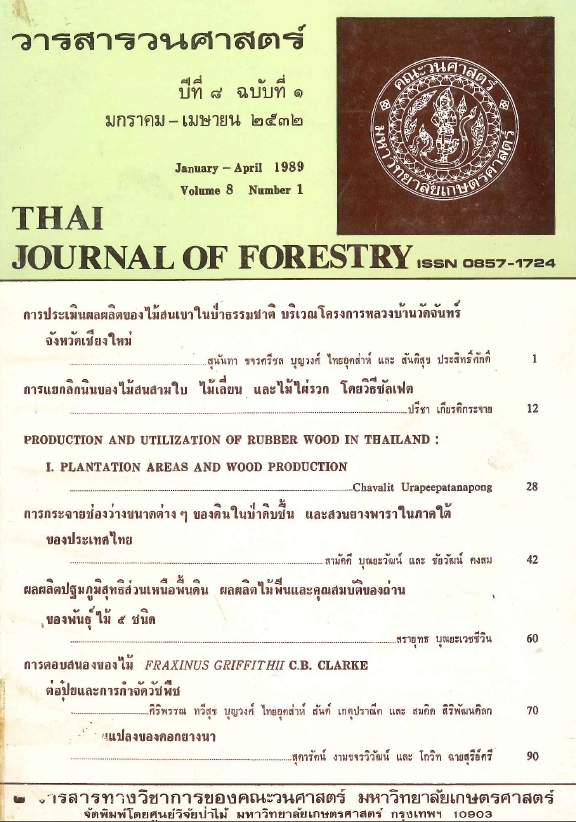การตอบสนองของไม้ FRAXINUS GRIFFITHII C.B. CLARKE ต่อปุ๋ยและการกำจัดวัชพืช
Main Article Content
บทคัดย่อ
การศึกษาผลของการใช้ปุ๋ยและการควบคุมวัชพืชต่อการเจริญเติบโตของไม้ Fraxinus griffithii C.B. Clarke อายุ ๑ ปี บริเวณดอยอ่างขาง จังหวัดเชียงใหม่ ได้วางแผนการสอนแบบ ๒ X ๔ factorial experiment in randomized block design 2 blocks 5 treatments โดยกำหนดให้ปุ๋ยและการควบคุมวัชพืชเป็น treatments คือใส่ปุ๋ย NPK (15-15-15) ในอัตรา ๑๐ กรัม/ต้น/ปี และไม่ใส่ปุ๋ยร่วมกับการควบคุมวัชพืชโดยใช้แรงงาน ๒ ครั้ง/ปี ควบคุมวัชพืชโดยใช้ Oxyfluorfen 0.5 kg (ai)/ha และ: oxyfluorfen 0.5 kg (ai)/ha + glyphosate 1.5 kg (ai)/ha ควบคุมวัชพืชโดยใช้ Oxyfluorfen 1.0 kg (ai)/ha และไม่ควบคุมวัชพืชระยะเวลาการศึกษาตั้งแต่เดือนมิถุนายน ๒๕๒๐ ถึงเดือนมิถุนายน ๒๕๓๐ โดยเริ่มใส่ปุ๋ยและควบคุมวัชพืชครั้งแรกในเดือนมิถุนายน และครั้งที่สองในเดือนตุลาคม วัดเส้นผ่าศูนย์กลางที่ระดับคอราก และความสูงทุกๆ ๓ เดือน ทำการวิเคราะห์ข้อมูลทางสถิติ โดยวิธี analysis of variance และเปรียบเทียบความแตกต่างของค่าเฉลี่ยโดยวิธี Duncan's new multiple-range test ตรวจนับอัตราการควบคุมวัชพืชหลังจากการใส่ปุ๋ยและควบคุมวัชพืชในครั้งแรกเป็นเวลา ๓๐ วัน ๔๕ วันและหลังจากการควบคุมวัชพืชครั้งที่ ๒ เป็นเวลา ๔๕ วัน ๑๔๕ วันและ ๒๕๐ วัน ตามลำดับ ซึ่งผลการศึกษาปรากฏดังนี้ การใส่ปุ๋ยให้แก่กล้าไม้ในอัตรา ๑๐ กรัม/ต้น/ปี ไม่มีผลทำให้การเจริญเติบโตทางเส้นผ่าศูนย์กลางคอราก และความสูงเพิ่มขึ้นอย่างมีนัยสำคัญทางสถิติ แต่การควบคุมวัชพืชนั้นพบว่ามีผลทำให้การเจริญเติบโตทางเส้นผ่าศูนย์กลาคอรากและความสูงเพิ่มขึ้น โดยไม้ Fraxinus griffithii ตอบสนองต่อการควบคุมวัชพืชโดยใช้สารเคมีและการใช้แรงงานคนแตกต่างกัน การใช้แรงงานคนควบคุมวัชพืชที่มีผลต่อการเจริญเติบโตน้อยกว่าการใช้สารเคมี ส่วนอัตราการควบคุมวัชพืชพบว่า สารเคมีสามารถควบคุมวัชพืชได้ดีกว่าการใช้แรงงานคน นอกจากนั้นการศึกษาในครั้งนี้ยังพบว่าและการควบคุมวัชพืชไม่มีปฏิกิริยาความสัมพันธ์ต่อกันแตกต่างอย่างมีนัยสำคัญทางสถิติ ผลการศึกษาครั้งนี้แสดงให้เห็นว่าการควบคุมวัชพืช มีผลต่อการเจริญเติบโตทางเส้นผ่าศูนย์กลางคอราก และความสูงของไม้ Fraxinus griffithii การควบคุมวัชพืชโดยใช้ oxyfluorfen 0.5 kg (ai)/ha ในเดือนมิถุนายน และ oxyfluorfen 0.5 kg (ai)/ha + glyphosate 1.5 kg (ai)/ha ในเดือนตุลาคเป็นวิธีการควบคุมวัชพืชที่เหมาะสมที่สุด เมื่อคำนึงถึงค่าใช้จ่ายร่วมกับผลตอบแทนทางความเพิ่มพูนการเจริญเติบโตของไม้ในปีแรก ที่ปลูกบริเวณสถานีเกษตรหลวงอ่างขาง
Downloads
Article Details

อนุญาตภายใต้เงื่อนไข Creative Commons Attribution-NonCommercial-NoDerivatives 4.0 International License.
ข้าพเจ้าและผู้เขียนร่วม (ถ้ามี) ขอรับรองว่า ต้นฉบับที่เสนอมานี้ยังไม่เคยได้รับการตีพิมพ์และไม่ได้อยู่ในระหว่างกระบวนการพิจารณาตีพิมพ์ลงในวารสารหรือสิ่งตีพิมพ์อื่นใด ข้าพเจ้าและผู้เขียนร่วม (ถ้ามี) ยอมรับหลักเกณฑ์และเงื่อนไขการพิจารณาต้นฉบับ ทั้งยินยอมให้กองบรรณาธิการมีสิทธิ์พิจารณาและตรวจแก้ต้นฉบับได้ตามที่เห็นสมควร พร้อมนี้ขอมอบลิขสิทธิ์ผลงานที่ได้รับการตีพิมพ์ให้แก่วารสารวนศาสตร์ คณะวนศาสตร์ มหาวิทยาลัยเกษตรศาสตร์ กรณีมีการฟ้องร้องเรื่องการละเมิดลิขสิทธิ์เกี่ยวกับภาพ กราฟ ข้อความส่วนใดส่วนหนึ่ง หรือ ข้อคิดเห็นที่ปรากฏในผลงาน ให้เป็นความรับผิดชอบของข้าพเจ้าและผู้เขียนร่วม (ถ้ามี) แต่เพียงฝ่ายเดียว และหากข้าพเจ้าและผู้เขียนร่วม (ถ้ามี) ประสงค์ถอนบทความในระหว่างกระบวนการพิจารณาของทางวารสาร ข้าพเจ้าและผู้เขียนร่วม (ถ้ามี) ยินดีรับผิดชอบค่าใช้จ่ายทั้งหมดที่เกิดขึ้นในกระบวนการพิจารณาบทความนั้น”


